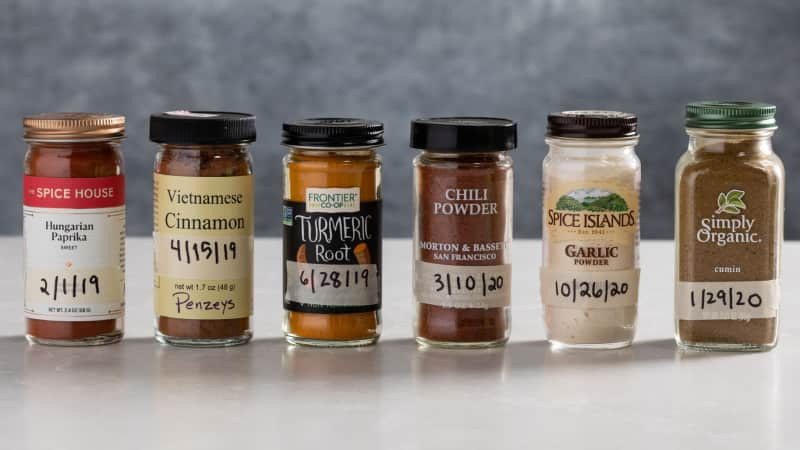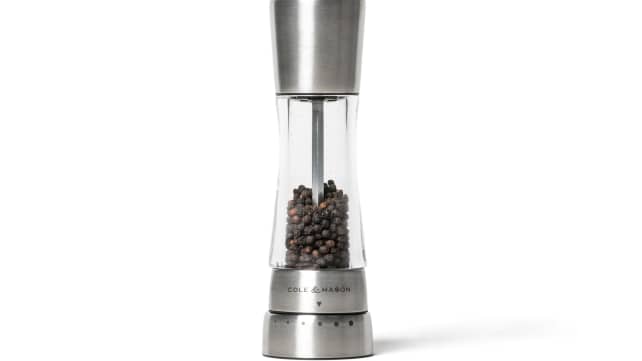Spices bring our food to life by adding flavor, fragrance, and even texture (think spice-crusted steaks or herb-coated goat cheese). In the test kitchen we define a "spice" as anything that comes from a plant that is dried and can flavor food. We know that salt is a mineral and herbs are sometimes put in a category of their own, but we’re including them in our guide because we use them often and in much the same way that we use spices.
Our Guide to Storing and Organizing Spices
Published Nov. 13, 2020.

Whole versus Ground
Grinding whole spices immediately before use releases the volatile compounds that give them their flavor and aroma, so it’s a great way to get a lot of punch from your spices. But we love the convenience of many preground spices. The trick to getting the best possible flavor from whole and ground spices is storing them properly and keeping track of their age (more on this in a minute).


There is one spice, though, we think should always be ground immediately before use: black peppercorns. In side-by-side comparisons, we found that freshly ground black peppercorns can taste spicy, pungent, floral, smoky, and/or citrusy depending on where and when the peppercorns were harvested, while store-bought preground black pepper tastes dull and dusty.
Purchasing Spices
Given how quickly their flavor, aroma, and color can degrade, it’s important to buy the freshest spices available. Unfortunately, there's no standard for dating spices, and many jars in the supermarket don't have best-by dates. We’ve seen a recent rise in companies that take a different approach: They ship direct to consumers, often specialize in single-origin spices, and frequently tout a commitment to partnering with small farms and promoting sustainable practices. It's similar to the more established trends in specialty chocolate and coffee. We're eager to monitor this development and see if/how it affects the spice industry.
In the meantime, we know that many people (including the members of our Kitchen Operations team) will continue to shop at grocery stores. We spoke with Ethan Frisch, cofounder of the single-origin spice company Burlap & Barrel, and we consulted The Spice Companion by Lior Lev Sercarz, the chef and owner of La Boîte, to compile a list of things to look for when shopping for spices.
- Check to see if the jars of the spice you’re buying have a best-by date (less than half of our own spices at home have them). If they do, look for a jar with the latest date.
- Look for spices that are bright and uniform in color. If a spice’s color has faded, it’s likely that the spice is old. And if you see both dark and light shades of color within the same jar, it could mean that the spice wasn’t harvested or stored properly.
- If you notice a lot of powder sitting in the bottom of a jar of whole spices or dried herbs, it could mean that the spice is old and has begun to break down.
- Buy what you think you’ll use in the next few months. Buying smaller amounts more often will help ensure that you’re using fresh, flavorful spices.
Storing and Organizing Spices
When whole and ground spices are exposed to light, air, and heat while stored, their flavors and aromas diminish, so we recommend storing them somewhere dark, dry, and temperate, such as a kitchen drawer or cabinet. Don’t keep spices right next to your stove, as the intense heat can spoil them. Although plastic and metal containers are acceptable, we recommend storing spices in small airtight glass containers. (Most of us don’t transfer our spices to different jars, but when we have the choice, we buy spices sold in glass jars rather than in plastic ones. In addition to allowing us to see how much is left in the jar, glass doesn't absorb flavors or odors and won't react with the volatile oils in spices.)

TEST KITCHEN TIP:
If you’re not sure how old your spices are, we have a quick test: Take a small amount of a spice and rub it between your fingers. If it still has a strong aroma, then it’s still good.
In the test kitchen, we keep our spices organized so that each one is visible and we can quickly locate what we need. We use a colored sticker on each spice bottle that corresponds to its category, and we store the bottles in groups. For example: Red stickers are for warm spices, and green ones are for herbs. We also put a piece of tape on each spice bottle to record the date we purchased the bottle; this helps us weed out expired bottles to keep our spices as fresh and flavorful as possible.
In general, we recommend replacing whole spices every two years and ground spices every year. Ground spices degrade faster because the flavor compounds are exposed to more air. If you’re not sure how old your spices are, we have a quick test: Take a small amount of a spice and rub it between your fingers. If it still has a strong aroma, then it’s still good.
Six Essential Spice-Related Pieces of Equipment

Salt Storage Container: Bee House Salt Box ($21) We like to keep salt storage containers near our stoves so that we can easily season food as we cook or add salt to a pot of boiling water. This one has a lid that protects the salt from kitchen messes and splatters.

Pepper Mill: Cole & Mason Derwent Pepper Mill ($50) We use ground pepper in almost every savory dish we make, so having a great pepper mill is a must. This one has six grind settings that are easy to set and use.

Spice Grinder: Krups Coffee and Spice Grinder ($18) This electric spice grinder is very proficient at producing exceptionally fine grinds of all spices.
Tip: To ensure that your spices grind evenly, lift the whole unit off the counter and shake it gently while grinding.

Mortar and Pestle: Frieling Goliath Natural Stone Mortar & Pestle ($58) A mortar and pestle is a great alternative to an electric spice grinder. You can either crack whole spices, such as peppercorns, for a textured crust or grind them into a powder. The bowl of our favorite mortar has a rough interior that grips ingredients while grinding, and its heavy pestle makes hand grinding easier.

Rasp-Style Grater: Microplane Premium Classic Zester/Grater ($15) This sharp rasp-style grater is especially adept at grating whole spices, such as nutmeg. We also use this tool for zesting citrus fruits, and grating hard cheeses, shallots, and garlic.

Skillet: All-Clad D3 Stainless 12" Fry Pan with Lid ($130) This test kitchen favorite is the perfect tool to use for toasting and blooming spices. Its light interior allows you to monitor the color of the spices.


Toasting and Blooming Spices
Our recipes often call for toasting (above left) or blooming (above right) dried spices before they are mixed with other ingredients because it enhances the spices’ flavors.
Toasting Spices: Applying direct heat to the spice brings the spice’s oils to the surface, resulting in a stronger aroma.
Blooming Spices: Most of the flavor compounds in spices are fat-soluble, so steeping spices in warm oil helps their complex flavors to emerge into a dish. A few spices, such as saffron, contain water-soluble compounds and benefit from soaking in warm water.